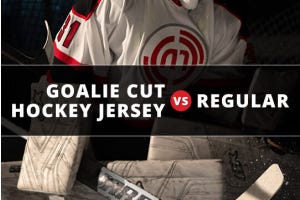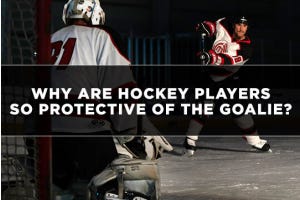Why Are Hockey Players So Protective of the Goalie?

Goaltender protection in hockey is a crucial aspect of the game, emphasizing the safety and well-being of the goalie, who serves as the last line of defense against opposing teams. Goalies face relentless shots and physical contact, making effective protection essential not only for their safety but also for the team's overall performance. The collective effort of the entire team is vital, as players are often quick to rally around their goalie, especially when they perceive an infringement or aggression from opponents. This instinct to defend their goalie stems from a strong sense of camaraderie and loyalty, as players understand that their success hinges on maintaining a secure and confident presence in the crease. When a goalie is touched or challenged, it often ignites aggressive reactions from teammates, fueled by the desire to protect their key player and assert their commitment to the team's unity. This dynamic not only enhances the emotional bond among players but also reinforces the importance of goalie protection within the competitive spirit of the game.
In this article, we will discuss:
The Role of the Goalie in Hockey
The goalie plays a critical role in a hockey game, serving as the last line of defense against opposing teams and directly influencing the outcome of the match. Their primary responsibility is to stop shots on goal, which requires quick reflexes, sharp focus, and exceptional positioning skills. Beyond simply blocking pucks, goalies also communicate with their teammates, guiding defensive strategies and ensuring players are positioned effectively to minimize scoring opportunities. A strong performance from the goalie can instill confidence throughout the team, motivating players to take risks and play aggressively, knowing they have a reliable protector behind them. Conversely, a shaky performance can lead to a loss of morale, causing players to hesitate or second-guess their decisions. Ultimately, the impact of a goalie extends far beyond the crease; their ability to make key saves and maintain composure under pressure is instrumental in shaping the team's overall performance and success in the game.
Unwritten Rules of Protecting the Goalie
Protect the Goal Line: Teammates must rally around the goalie to protect them from aggressive opponents, particularly during scrums. For example, if an opposing player crashes the net, it’s common for teammates to step in and confront the aggressor, showcasing their loyalty and commitment to safeguarding their goalie.
Response to Physicality: If an opponent makes a hard hit on a goalie, it’s expected that players will respond immediately, either through a fight or by physically confronting the aggressor. This can be seen in various anecdotes where a goalie is hit hard, leading to teammates rushing in to defend them, reinforcing the idea that a goalie must never be left to fend for themselves.
Respect the Crease: Players know not to enter the goalie’s crease unnecessarily, as this can lead to conflict. Goalies often communicate this boundary with body language or verbal cues. Instances where players intentionally invade the crease often lead to immediate retribution from the defending team, illustrating the importance of maintaining respect for this space.
Puck Handling: Goalies who handle the puck effectively earn respect, but if they misplay it, teammates may feel compelled to cover for them. This unwritten rule fosters a collective responsibility where players will often compensate for a misplay by the goalie, either by blocking shots or retrieving the puck.
Celebrating Saves: Players are encouraged to celebrate key saves made by the goalie, which fosters a sense of unity and camaraderie. Anecdotes abound of teams rallying around a standout save during crucial moments, emphasizing the bond between goalie and teammates.
Goalie Fights: While rare, if a goalie gets into a fight, it’s customary for teammates to back them up. This can create memorable moments, such as a goalie standing up to an opposing player and teammates jumping in to support them, showcasing the deep respect players have for their goalie’s courage.
Apologies for Mistakes: If a defenseman makes a mistake that leads to a goal against, it’s often seen as an unwritten rule to apologize to the goalie afterward, acknowledging their role in the shared responsibility of protecting the net.
Historical Instances of Goalie Protection
The Battle of Alberta: A Legendary Showdown
One of the most famous instances of goalie protection occurred during the intense rivalry between the Edmonton Oilers and the Calgary Flames, known as the Battle of Alberta. In a particularly heated matchup in the 1980s, Oilers goalie Grant Fuhr found himself under siege from aggressive Flames players. After a hard hit on Fuhr, Oilers forward Dave Semenko immediately stepped in, challenging the opponent and igniting a full-blown brawl on the ice. Semenko’s actions not only demonstrated the unbreakable bond between teammates but also showcased the fierce loyalty that players have for their goaltenders, setting the tone for the game and rallying the Oilers to victory.
Lundqvist Hit in Dallas
When Cody Eakin hit Henrik Lundqvist in the head during a game between the Dallas Stars and New York Rangers in December 2016, the Rangers were quick to respond. Eakin's hit on Lundqvist was a dangerous charging play that led to a suspension, but the Rangers' reaction on the ice was immediate. Derek Stepan, Chris Kreider, and other Rangers players immediately came to Lundqvist's defense. They aggressively confronted Eakin, showing their loyalty to their goaltender. Coach Alain Vigneault was vocal about his displeasure with the hit, calling it dangerous and criticizing Eakin’s reckless behavior. The Rangers made it clear they would protect their goalie, standing by Lundqvist in a display of team unity.
The 2010 Stanley Cup Finals: Antti Niemi's Defense
In the 2010 Stanley Cup Finals, Chicago Blackhawks goalie Antti Niemi faced relentless pressure from the Philadelphia Flyers. In a pivotal moment of Game 6, Niemi was run into by an opponent, prompting Blackhawks players, including Duncan Keith and Brent Seabrook, to immediately confront the offender. Their swift actions not only protected Niemi but also showcased the camaraderie within the team. The Blackhawks went on to win the Stanley Cup that year, with Niemi's performance bolstered by the knowledge that his teammates had his back.
The Psychological Impact of Protecting the Goalie
The psychological aspect of goalie protection plays a significant role in shaping team morale, the goalie’s confidence, and overall team dynamics. When teammates demonstrate their commitment to safeguarding their goalie, it fosters a sense of unity and trust within the group. This support not only boosts the morale of the entire team but also instills a deeper sense of responsibility among players, encouraging them to work together to achieve their common goals. For goalies, knowing that their teammates are willing to protect them creates a safe environment, enhancing their confidence to take risks and perform under pressure. As former NHL player and goalie coach Ian Clark noted, “When a goalie feels supported by their team, they can focus on making saves without worrying about getting run over.” This sentiment is echoed by many players who believe that this protective culture enhances their on-ice performance. Ultimately, the collective effort to protect the goalie reinforces the psychological bonds within the team, leading to improved communication and cohesion that can significantly impact the overall dynamics and success of the team.
Goalie Rules in Hockey Explained
In hockey, the official rules regarding goalies are designed to protect these key players while maintaining the integrity of the game. According to the NHL rules, goalies cannot be subjected to contact within the crease, which is the area directly in front of the goal. This protection is in place to ensure that goalies can effectively perform their primary responsibility of stopping pucks without the risk of injury from aggressive opponents. When players enter this protected zone, any contact made with the goalie is deemed a violation, leading to penalties such as minor penalties for goaltender interference. However, outside the crease, goalies can be subjected to legal contact, particularly if they are playing the puck. This allowance stems from the understanding that goalies are also players on the ice, and they must be able to engage in the game beyond their crease. The distinction between protected and unprotected areas aims to balance the need for goalie safety with the fast-paced nature of hockey, allowing for exciting plays while safeguarding the players in vulnerable positions.
Why Are Hockey Players So Protective of the Goalie FAQs
Are there specific penalties for attacking a goalie in hockey?
Yes, penalties for attacking a goalie include minor penalties for goaltender interference and major penalties for fighting or roughing, depending on the severity of the contact.
How do goalies handle the pressure of being protected?
Goalies often handle this pressure by focusing on their performance, relying on their teammates for support, and cultivating a mental approach that emphasizes confidence and trust in their team.
Who are some famous enforcers known for protecting the goalie?
Notable enforcers include Bob Probert, Dave Semenko, and Rob Ray, who were known for stepping in to defend their goalies during intense situations on the ice.
Do other sports have similar protection rules for their goalkeepers?
Yes, sports like soccer and lacrosse have rules protecting their goalkeepers from unnecessary contact, ensuring they can perform their roles without excessive risk of injury.
What are the official rules regarding goalie interference?
Goal interference occurs when an opposing player makes contact with the goalie while they are in the crease or impedes their ability to make a save. This results in a penalty for the offending player and can lead to disallowed goals if the contact affects the play.









Login and Registration Form
or
Create an account